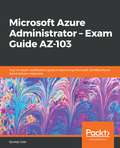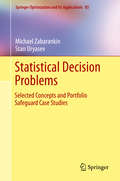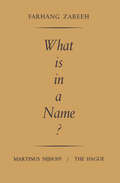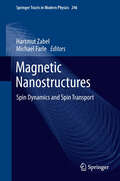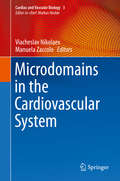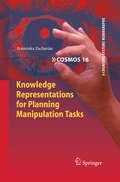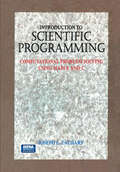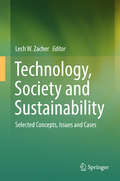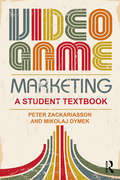- Table View
- List View
Microsoft Azure Administrator – Exam Guide AZ - 103: Your In-depth Certification Guide In Becoming Microsoft Certified Azure Administrator Associate
by Sjoukje ZaalMicrosoft Azure Administrator- Exam Guide AZ-103 is a complete guide that will help you master topics related to Azure administrator practices. Using this guide, you will have all the information required to ace the AZ-103 exam and become a Microsoft Azure administrator expert.
Implementing Microsoft Azure Architect Technologies: A guide to preparing for the AZ-303 Microsoft Azure Architect Technologies certification exam
by Sjoukje Zaal Brett HargreavesBecome a certified Azure Architect and learn how to design effective solutions that span compute, security, networking, and developmentKey FeaturesDiscover how you can design and architect powerful and cost-effective solutions on Microsoft AzurePrepare to achieve AZ-303 certification with the help of mock tests and practice questionsEnhance your computing, networking, storage, and security skills to design modern cloud-based solutionsBook DescriptionFrom designing solutions on Azure to configuring and managing virtual networks, the AZ-303 certification validates your knowledge and skills for all this and much more. Whether you want to take the certification exam or gain hands-on experience in administering, developing, and architecting Azure solutions, this study guide will help you get started. Divided into four modules, this book systematically takes you through the wide range of concepts and features covered in the AZ-303 exam. The first module demonstrates how to implement and monitor infrastructure. You'll develop the skills required to deploy and manage core Azure components such as virtual machines, networking, storage, and Active Directory (AD). As you progress, you'll build on that knowledge and learn how to create resilient and secure applications before moving on to working with web apps, functions, and containers. The final module will get you up to speed with data platforms such as SQL and Cosmos DB, including how to configure the different high availability options. Finally, you'll solve mock tests and assess yourself with the answers provided to get ready to take the exam with confidence. By the end of this book, you'll have learned the concepts and techniques you need to know to prepare for the AZ-303 exam and design effective solutions on Microsoft Azure.What you will learnManage Azure subscriptions and resourcesEnsure governance and compliance with policies, roles, and blueprintsBuild, migrate, and protect servers in AzureConfigure, monitor, and troubleshoot virtual networksManage Azure AD and implement multi-factor authenticationConfigure hybrid integration with Azure AD ConnectFind out how you can monitor costs, performance, and securityDevelop solutions that use Cosmos DB and Azure SQL DatabaseWho this book is forThis book is for solution architects and experienced developers who advise stakeholders and translate business requirements into secure, scalable, and reliable solutions. Technical architects interested in learning more about designing cloud solutions will also find this book useful. Prior experience and knowledge of various aspects of IT operations, including networking, security, business continuity, disaster recovery, budgeting, and governance, will assist with understanding the concepts covered in the book.
Statistical Decision Problems: Selected Concepts and Portfolio Safeguard Case Studies (Springer Optimization and Its Applications #85)
by Michael Zabarankin Stan UryasevStatistical Decision Problems presents a quick and concise introduction into the theory of risk, deviation and error measures that play a key role in statistical decision problems. It introduces state-of-the-art practical decision making through twenty-one case studies from real-life applications. The case studies cover a broad area of topics and the authors include links with source code and data, a very helpful tool for the reader. In its core, the text demonstrates how to use different factors to formulate statistical decision problems arising in various risk management applications, such as optimal hedging, portfolio optimization, cash flow matching, classification, and more. The presentation is organized into three parts: selected concepts of statistical decision theory, statistical decision problems, and case studies with portfolio safeguard. The text is primarily aimed at practitioners in the areas of risk management, decision making, and statistics. However, the inclusion of a fair bit of mathematical rigor renders this monograph an excellent introduction to the theory of general error, deviation, and risk measures for graduate students. It can be used as supplementary reading for graduate courses including statistical analysis, data mining, stochastic programming, financial engineering, to name a few. The high level of detail may serve useful to applied mathematicians, engineers, and statisticians interested in modeling and managing risk in various applications.
Magnetic Nanostructures: Spin Dynamics and Spin Transport (Springer Tracts in Modern Physics #246)
by Hartmut Zabel Michael FarleNanomagnetism and spintronics is a rapidly expanding and increasingly important field of research with many applications already on the market and many more to be expected in the near future. This field started in the mid-1980s with the discovery of the GMR effect, recently awarded with the Nobel prize to Albert Fert and Peter Grünberg. The present volume covers the most important and most timely aspects of magnetic heterostructures, including spin torque effects, spin injection, spin transport, spin fluctuations, proximity effects, and electrical control of spin valves. The chapters are written by internationally recognized experts in their respective fields and provide an overview of the latest status.
Stochastic Adaptive Search for Global Optimization (Nonconvex Optimization and Its Applications #72)
by Z.B. ZabinskyThe field of global optimization has been developing at a rapid pace. There is a journal devoted to the topic, as well as many publications and notable books discussing various aspects of global optimization. This book is intended to complement these other publications with a focus on stochastic methods for global optimization. Stochastic methods, such as simulated annealing and genetic algo rithms, are gaining in popularity among practitioners and engineers be they are relatively easy to program on a computer and may be cause applied to a broad class of global optimization problems. However, the theoretical performance of these stochastic methods is not well under stood. In this book, an attempt is made to describe the theoretical prop erties of several stochastic adaptive search methods. Such a theoretical understanding may allow us to better predict algorithm performance and ultimately design new and improved algorithms. This book consolidates a collection of papers on the analysis and de velopment of stochastic adaptive search. The first chapter introduces random search algorithms. Chapters 2-5 describe the theoretical anal ysis of a progression of algorithms. A main result is that the expected number of iterations for pure adaptive search is linear in dimension for a class of Lipschitz global optimization problems. Chapter 6 discusses algorithms, based on the Hit-and-Run sampling method, that have been developed to approximate the ideal performance of pure random search. The final chapter discusses several applications in engineering that use stochastic adaptive search methods.
Couchbase Essentials
by John ZablockiThis book is for those application developers who want to achieve greater flexibility and scalability from their software. Whether you are familiar with other NoSQL databases or have only used relational systems, this book will provide you with enough background to move you along at your own pace. If you are new to NoSQL document databases, the design discussions and introductory material will give you the information you need to get started with Couchbase.
Human-Computer Interaction: The Agency Perspective (Studies in Computational Intelligence #396)
by Marielba Zacarias José Valente De OliveiraAgent-centric theories, approaches and technologies are contributing to enrich interactions between users and computers. This book aims at highlighting the influence of the agency perspective in Human-Computer Interaction through a careful selection of research contributions. Split into five sections; Users as Agents, Agents and Accessibility, Agents and Interactions, Agent-centric Paradigms and Approaches, and Collective Agents, the book covers a wealth of novel, original and fully updated material, offering: To provide a coherent, in depth, and timely material on the agency perspective in HCITo offer an authoritative treatment of the subject matter presented by carefully selected authors To offer a balanced and broad coverage of the subject area, including, human, organizational, social, as well as technological concerns.ü To offer a hands-on-experience by covering representative case studies and offering essential design guidelines The book will appeal to a broad audience of researchers and professionals associated to software engineering, interface design, accessibility, as well as agent-based interaction paradigms and technology.
Power Estimation and Optimization Methodologies for VLIW-based Embedded Systems
by Vittorio Zaccaria M.G. Sami Donatella Sciuto Cristina SilvanoThis volume introduces innovative power estimation and optimization methodologies to support the design of low power embedded systems based on high-performance VLIW microprocessors. A VLIW processor is a (generally) pipelined processor that can execute, in each clock cycle, a set of explicitly parallel operations.
Microdomains in the Cardiovascular System (Cardiac and Vascular Biology #4)
by Manuela Zaccolo Viacheslav NikolaevThe book comprehensively presents new findings in cardiovascular research related to signaling microdomains in health and disease. Important second messengers such as cAMP, cGMP, calcium and their role in microdomain signaling are discussed. The book offers and explains methodical approaches and technical ways how to successfully analyze microdomain signaling, also in the context of disease. It further provides scientific perspectives and strategies that are based on the concept of signaling within microdomains and that can revolutionize pharmacology and eventually lead to the effective treatment of cardiovascular diseases in future.This book is written for scientists in cardiovascular research, pharmacology, molecular and cellular biology as well as medical doctors in cardiology, angiology and nephrology.
Python Parallel Programming Cookbook
by Giancarlo ZacconeMaster efficient parallel programming to build powerful applications using Python About This Book • Design and implement efficient parallel software • Master new programming techniques to address and solve complex programming problems • Explore the world of parallel programming with this book, which is a go-to resource for different kinds of parallel computing tasks in Python, using examples and topics covered in great depth Who This Book Is For Python Parallel Programming Cookbook is intended for software developers who are well versed with Python and want to use parallel programming techniques to write powerful and efficient code. This book will help you master the basics and the advanced of parallel computing. What You Will Learn • Synchronize multiple threads and processes to manage parallel tasks • Implement message passing communication between processes to build parallel applications • Program your own GPU cards to address complex problems • Manage computing entities to execute distributed computational tasks • Write efficient programs by adopting the event-driven programming model • Explore the cloud technology with DJango and Google App Engine • Apply parallel programming techniques that can lead to performance improvements In Detail This book will teach you parallel programming techniques using examples in Python and will help you explore the many ways in which you can write code that allows more than one process to happen at once. Starting with introducing you to the world of parallel computing, it moves on to cover the fundamentals in Python. This is followed by exploring the thread-based parallelism model using the Python threading module by synchronizing threads and using locks, mutex, semaphores queues, GIL, and the thread pool. Next you will be taught about process-based parallelism where you will synchronize processes using message passing along with learning about the performance of MPI Python Modules. You will then go on to learn the asynchronous parallel programming model using the Python asyncio module along with handling exceptions. Moving on, you will discover distributed computing with Python, and learn how to install a broker, use Celery Python Module, and create a worker. You will understand anche Pycsp, the Scoop framework, and disk modules in Python. Further on, you will learnGPU programming withPython using the PyCUDA module along with evaluating performance limitations. Style and approach A step-by-step guide to parallel programming using Python, with recipes accompanied by one or more programming examples. It is a practically oriented book and has all the necessary underlying parallel computing concepts.
Deep Learning with TensorFlow - Second Edition: Explore neural networks and build intelligent systems with Python
by Giancarlo Zaccone Md. Rezaul KarimDelve into neural networks, implement deep learning algorithms, and explore layers of data abstraction with the help of TensorFlow.About This BookLearn how to implement advanced techniques in deep learning with Google's brainchild, TensorFlowExplore deep neural networks and layers of data abstraction with the help of this comprehensive guideGain real-world contextualization through some deep learning problems concerning research and applicationWho This Book Is ForThe book is for people interested in machine learning and machine intelligence. A rudimentary level of programming in one language is assumed, as is a basic familiarity with computer science techniques and technologies, including a basic awareness of computer hardware and algorithms. Some competence in mathematics is needed to the level of elementary linear algebra and calculus.What You Will LearnApply deep machine intelligence and GPU computing with TensorFlowAccess public datasets and use TensorFlow to load, process, and transform the dataDiscover how to use the high-level TensorFlow API to build more powerful applicationsUse deep learning for scalable object detection and mobile computingTrain machines quickly to learn from data by exploring reinforcement learning techniquesExplore active areas of deep learning research and applicationsIn DetailDeep learning is a branch of machine learning algorithms based on learning multiple levels of abstraction. Neural networks, which are at the core of deep learning, are being used in predictive analytics, computer vision, natural language processing, time series forecasting, and to perform a myriad of other complex tasks.This book is conceived for developers, data analysts, machine learning practitioners and deep learning enthusiasts who want to build powerful, robust, and accurate predictive models with the power of TensorFlow, combined with other open source Python libraries.Throughout the book, you'll learn how to develop deep learning applications for machine learning systems using Feedforward Neural Networks, Convolutional Neural Networks, Recurrent Neural Networks, Autoencoders, and Factorization Machines. Discover how to attain deep learning programming on GPU in a distributed way.You'll come away with an in-depth knowledge of machine learning techniques and the skills to apply them to real-world projects.Style and approachThis step-by-step guide explores common, and not so common, deep neural networks, and shows how they can be exploited in the real world with complex raw data. Benefit from practical examples, and learn how to implement different types of neural nets to build smart applications related to text, speech, and image data processing.
Deep Learning with TensorFlow - Second Edition: Explore neural networks and build intelligent systems with Python
by Giancarlo Zaccone Md. Rezaul KarimDelve into neural networks, implement deep learning algorithms, and explore layers of data abstraction with the help of TensorFlow.About This BookLearn how to implement advanced techniques in deep learning with Google's brainchild, TensorFlowExplore deep neural networks and layers of data abstraction with the help of this comprehensive guideGain real-world contextualization through some deep learning problems concerning research and applicationWho This Book Is ForThe book is for people interested in machine learning and machine intelligence. A rudimentary level of programming in one language is assumed, as is a basic familiarity with computer science techniques and technologies, including a basic awareness of computer hardware and algorithms. Some competence in mathematics is needed to the level of elementary linear algebra and calculus.What You Will LearnApply deep machine intelligence and GPU computing with TensorFlowAccess public datasets and use TensorFlow to load, process, and transform the dataDiscover how to use the high-level TensorFlow API to build more powerful applicationsUse deep learning for scalable object detection and mobile computingTrain machines quickly to learn from data by exploring reinforcement learning techniquesExplore active areas of deep learning research and applicationsIn DetailDeep learning is a branch of machine learning algorithms based on learning multiple levels of abstraction. Neural networks, which are at the core of deep learning, are being used in predictive analytics, computer vision, natural language processing, time series forecasting, and to perform a myriad of other complex tasks.This book is conceived for developers, data analysts, machine learning practitioners and deep learning enthusiasts who want to build powerful, robust, and accurate predictive models with the power of TensorFlow, combined with other open source Python libraries.Throughout the book, you'll learn how to develop deep learning applications for machine learning systems using Feedforward Neural Networks, Convolutional Neural Networks, Recurrent Neural Networks, Autoencoders, and Factorization Machines. Discover how to attain deep learning programming on GPU in a distributed way.You'll come away with an in-depth knowledge of machine learning techniques and the skills to apply them to real-world projects.Style and approachThis step-by-step guide explores common, and not so common, deep neural networks, and shows how they can be exploited in the real world with complex raw data. Benefit from practical examples, and learn how to implement different types of neural nets to build smart applications related to text, speech, and image data processing.
Deep Learning with TensorFlow
by Giancarlo Zaccone Md. Rezaul Karim Ahmed MenshawyDelve into neural networks, implement deep learning algorithms, and explore layers of data abstraction with the help of this comprehensive TensorFlow guide About This Book • Learn how to implement advanced techniques in deep learning with Google's brainchild, TensorFlow • Explore deep neural networks and layers of data abstraction with the help of this comprehensive guide • Real-world contextualization through some deep learning problems concerning research and application Who This Book Is For The book is intended for a general audience of people interested in machine learning and machine intelligence. A rudimentary level of programming in one language is assumed, as is a basic familiarity with computer science techniques and technologies, including a basic awareness of computer hardware and algorithms. Some competence in mathematics is needed to the level of elementary linear algebra and calculus. What You Will Learn • Learn about machine learning landscapes along with the historical development and progress of deep learning • Learn about deep machine intelligence and GPU computing with the latest TensorFlow 1.x • Access public datasets and utilize them using TensorFlow to load, process, and transform data • Use TensorFlow on real-world datasets, including images, text, and more • Learn how to evaluate the performance of your deep learning models • Using deep learning for scalable object detection and mobile computing • Train machines quickly to learn from data by exploring reinforcement learning techniques • Explore active areas of deep learning research and applications In Detail Deep learning is the step that comes after machine learning, and has more advanced implementations. Machine learning is not just for academics anymore, but is becoming a mainstream practice through wide adoption, and deep learning has taken the front seat. As a data scientist, if you want to explore data abstraction layers, this book will be your guide. This book shows how this can be exploited in the real world with complex raw data using TensorFlow 1.x. Throughout the book, you'll learn how to implement deep learning algorithms for machine learning systems and integrate them into your product offerings, including search, image recognition, and language processing. Additionally, you'll learn how to analyze and improve the performance of deep learning models. This can be done by comparing algorithms against benchmarks, along with machine intelligence, to learn from the information and determine ideal behaviors within a specific context. After finishing the book, you will be familiar with machine learning techniques, in particular the use of TensorFlow for deep learning, and will be ready to apply your knowledge to research or commercial projects. Style and approach This step-by-step guide will explore common, and not so common, deep neural networks and show how these can be exploited in the real world with complex raw data. With the help of practical examples, you will learn how to implement different types of neural nets to build smart applications related to text, speech, and image data processing.
Information Technology in Organisations and Societies: Multidisciplinary Perspectives from AI to Technostress
by Zach W. Y. Lee, Tommy K. H. Chan and Christy M. K. CheungInformation technology (IT) use has generally been regarded as a positive phenomenon which always generates desirable outcomes. Recent years, however, have witnessed increasing negative consequences resulted from IT use. Emerging issues include individual users have experienced technostress from personal social media usage as well as IT use in the workplace; and organisations have experienced a loss in productivity and assets due to employees’ non-compliance with information security policies.Themes explored throughout the book include: AI and its Implications for Organisations Augmented Reality Social Media Stress Cognitive Absorption of Technology Information Technology in Organisations and Societies: Multidisciplinary Perspectives from AI to Technostress represents a collective effort that not only consolidates studies on key issues and phenomena concerning the positive and negative aspects of IT use but also prescribes future research avenues in related research domains. It is particularly relevant to academics and researchers working on IT use research and can be used as a handy reference guide by those working in the field.
Information Technology in Organisations and Societies: Multidisciplinary Perspectives from AI to Technostress
by Zach W. Y. Lee, Tommy K. H. Chan and Christy M. K. CheungInformation technology (IT) use has generally been regarded as a positive phenomenon which always generates desirable outcomes. Recent years, however, have witnessed increasing negative consequences resulted from IT use. Emerging issues include individual users have experienced technostress from personal social media usage as well as IT use in the workplace; and organisations have experienced a loss in productivity and assets due to employees’ non-compliance with information security policies.Themes explored throughout the book include: AI and its Implications for Organisations Augmented Reality Cognitive Absorption of Technology Information Technology in Organisations and Societies: Multidisciplinary Perspectives from AI to Technostress represents a collective effort that not only consolidates studies on key issues and phenomena concerning the positive and negative aspects of IT use but also prescribes future research avenues in related research domains. It is particularly relevant to academics and researchers working on IT use research and can be used as a handy reference guide by those working in the field.
Knowledge Representations for Planning Manipulation Tasks (Cognitive Systems Monographs #16)
by Franziska ZachariasIn this book, the capability map, a novel general representation of the kinematic capabilities of a robot arm, is introduced. The capability map allows to determine how well regions of the workspace are reachable for the end effector in different orientations. It is a representation that can be machine processed as well as intuitively visualized for the human. The capability map and the derived algorithms are a valuable source of information for high- and low-level planning processes. The versatile applicability of the capability map is shown by examples from several distinct application domains. In human-robot interaction, a bi-manual interface for tele-operation is objectively evaluated. In low-level geometric planning, more human-like motion is planned for a humanoid robot while also reducing the computation time. And in high-level task reasoning, the suitability of a robot for a task is evaluated.
Introduction to Scientific Programming: Computational Problem Solving Using Maple and C
by Joseph L. Zachary"Introduction to Computational Science" was developed over a period of two years at the University of Utah Department of Computer Science in conjunction with the U.S. Department of Energy-funded Undergraduate Computation in Engineering Science (UCES) program. Each chapter begins by introducing a problem and then guiding the student through its solution. The computational techniques needed to solve the problem are developed as necassary, making the motivation for learning the computing alwasy apparent. Each chapter will introduce a single problem that will be used to motivate a single computing concept. The notes currently consist of 15 chapters. The first seven chapters deal with Maple and the last eight with C. The textbook will contain 20 to 30 chapters covering a similar mix of concepts at a finer level of detail.
Technology, Society and Sustainability: Selected Concepts, Issues and Cases
by Lech W. ZacherThis collection is a multidisciplinary and multicultural contribution to the current sustainability discourse. It is focused on two main dimensions of our world: complexity and diversity. Desirable and urgent transition of socio-technological systems toward a sustainability trajectory of development requires a better understanding of technological trends and social transformations. General advancement of technology does not produce identical changes in various societies, differentiated economically and culturally. Moreover, the abilities to approach sustainable development change over time and space. As a result there is a constant need for continuing research, analyses, and discussions concerning changing contexts and adequacy of strategies and policies. Authors from twelve countries and of different academic and cultural settings present their insights, analyses and recommendations. The collection is focused both on contexts and on activities leading to sustainable trajectories in various domains of economy and social life.Continuing research and discussion is needed to better understand these challenges and to prepare the appropriate strategies and solutions. Development of socio-technological systems is nowadays very complex; moreover, the world we live in is extremely diverse. Therefore, sustainability discourse must be ongoing, introducing new ideas, concepts, theories, evidence and experience by various parties—academics, professionals, and practitioners.
Übungsbuch Regelungstechnik: Klassische, modell- und wissensbasierte Verfahren (Studium Technik)
by Serge ZacherDas Übungsbuch Regelungstechnik beinhaltet klausurrelevante Musteraufgaben zu klassischen, modellbasierten und wissensbasierten Verfahren der Regelungstechnik. Auch neue Aufgaben zu noch nicht traditionellen Kapiteln der Regelungstechnik wie Fuzzy- und Neuro-Regelungen werden mit ausführlichen Lösungen behandelt. Bei allen Aufgaben sind Lösungen ausführlich beschrieben, einige davon sind zum besseren Verständnis mit MATLAB / Simulink simuliert oder mit Flash MX animiert. Die Aufgaben sind für Studierende der Elektrotechnik und des Maschinenbaus an Fachhochschulen geeignet. Bei der Gestaltung von Lösungswegen wurden die Bedürfnisse von berufsintegrierten Ingenieur-Studiengängen (BIS und KIS) berücksichtigt. Die dritte Auflage ist überarbeitet und um die Themen Systemidentifikation, adaptive Regelsysteme, Entwurf optimaler Zustandsregler und nichtlineare Regelsysteme erweitert.
Virtual Reality and Mixed Reality: 19th EuroXR International Conference, EuroXR 2022, Stuttgart, Germany, September 14–16, 2022, Proceedings (Lecture Notes in Computer Science #13484)
by Gabriel Zachmann Mariano Alcañiz Raya Xubo Yang Partrick Bourdot Maud Marchal Jeanine StefanucciThis book constitutes the refereed proceedings of the 19th International Conference on Virtual Reality and Mixed Reality, EuroXR 2022, held in Stuttgart, Germany, in September 2022.The 6 full and 2 short papers were carefully reviewed and selected from 37 submissions. The conference presents contributions on results and insights in Virtual Reality (VR), Augmented Reality (AR), and Mixed Reality (MR), commonly referred to under the umbrella of Extended Reality (XR), including software systems, immersive rendering technologies, 3D user interfaces, and applications.
Virtual Reality and Mixed Reality: 20th EuroXR International Conference, EuroXR 2023, Rotterdam, The Netherlands, November 29 – December 1, 2023, Proceedings (Lecture Notes in Computer Science #14410)
by Gabriel Zachmann Krzysztof Walczak Omar A. Niamut Kyle Johnsen Wolfgang Stuerzlinger Mariano Alcañiz-Raya Greg Welch Patrick BourdotThis book constitutes the refereed proceedings of the 20th International Conference on Virtual Reality and Mixed Reality, EuroXR 2023, held in Rotterdam, the Netherlands, during November 29-December 1, 2023. The 14 full papers presented together with 2 short papers were carefully reviewed and selected from 42 submissions. The papers are grouped into the following topics: Interaction in Virtual Reality; Designing XR Experiences; and Human Factors in VR: Performance, Acceptance, and Design.
Stargazing Under Suburban Skies: A Star-Hopper's Guide (The Patrick Moore Practical Astronomy Series)
by Malcolm Zack Andrew Gannon John McRobertsAnyone interested in astronomy battles with the conveniences of modern living – street lights, advertising and security lighting, tall buildings, and even the occasional tree. More than 85% of the population now lives in crowded and light-polluted towns and cities. This book is for those who live in or near towns and cities and own relatively modest equipment, although observers with larger instruments will still find many of the target objects of interest. The book encourages the use of star-hopping techniques to find objects in the night sky.Included is a list of 100 popular deep sky objects, ranked according to how difficult they are to find. Each object is described and has companion star-hopping charts, images and sometimes sketches. As a result, readers can gain a sense of their own backyard view from Earth. There is also a top 30 list of lunar objects, a section on planetary observing, annotated lists of popular astronomy apps and software, and tips on how to make the most of your location.Stargazing Under Suburban Skies: A Star-Hopper’s Guide is the essential companion to what can be seen and how, regardless of the obstacles.
Video Game Marketing: A student textbook
by Peter Zackariasson Mikolaj DymekThe video game industry has been one of the fastest-growing cultural phenomena of our times with market conditions that demand a specific skill set from its marketers. To a new generation of "indie gamers", being a game developer isn’t just about design and production, a successful video game demands entrepreneurial skills and astute business acumen. The creators need to know what their customers want, how to reach those customers and how to sell to them. Video Game Marketing: A student textbook is for development students or aspiring developers who want to know how to promote and sell the results of their efforts. This book is a much-needed guide to: • the essentials of marketing strategy; • video games as products or services; • marketing research for game development; • branding video games; • marketing through game: gamification, advergames. Replete with pedagogy to aid learning such as objectives and discussion questions for each chapter, this book is all that aspiring video game developers will need to unleash the potential of their games.
Video Game Marketing: A student textbook
by Peter Zackariasson Mikolaj DymekThe video game industry has been one of the fastest-growing cultural phenomena of our times with market conditions that demand a specific skill set from its marketers. To a new generation of "indie gamers", being a game developer isn’t just about design and production, a successful video game demands entrepreneurial skills and astute business acumen. The creators need to know what their customers want, how to reach those customers and how to sell to them. Video Game Marketing: A student textbook is for development students or aspiring developers who want to know how to promote and sell the results of their efforts. This book is a much-needed guide to: • the essentials of marketing strategy; • video games as products or services; • marketing research for game development; • branding video games; • marketing through game: gamification, advergames. Replete with pedagogy to aid learning such as objectives and discussion questions for each chapter, this book is all that aspiring video game developers will need to unleash the potential of their games.
